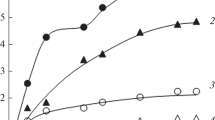Abstract
Adsorption of poly(L-lysine) on surface-attached poly(methacrylic acid) monolayers formed through in situ free radical polymerization was investigated. A strong “template effect” was observed for the adsorption of poly(L-lysine) on poly(methacrylic acid) layers, which were perpendicularly grown from the surface of substrates. The adsorbed amount of poly(amino acid) increases linearly with the increase in initial layer thickness of poly(methacrylic acid) monolayers. In addition, the adsorbed poly(amino acid) is relatively stable in medium concentration of salt solution but can be completely released from the brush in high salt concentration.
Similar content being viewed by others
References
Kuroki H, Tokarev I, Minko S. Responsive Surfaces for Life Science Applications[J]. Ann. Rev. Mater. Res., 2012,42: 343–372
Krishnamoorthy M, Hakobyan S, Ramstedt M, et al. Surface-initiated polymer Brushes in the Biomedical Field: Applications in Membrane Science, Biosensing, Cell Culture, Regenerative Medicine and Antibacterial Coatings[J]. Chem. Rev., 2014, 114(21): 10976–11026
Wei Q, Becherer T, Angioletti-Uberti S, et al. Protein Interactions with polymer Coatings and Biomaterials. Angew[J]. Chem. Inter. Ed., 2014 53(31): 8004–8031
Krivosheeva O, De dinate A, Claesson Per M. Salt-and pH-induced Desorption: Comparison between Non-aggregated and Aggregated Mussel Adhesive Protein, Mefp-1, and a Synthetic Cationic Polyelectrolyte[J]. J. Coll. Inter. Sci., 2013, 408: 82–86
Ladam G, Gergely C, Senger B. Protein Interactions with Polyelectrolyte Multilayers: Interactions between Human Serum Albumin and Polystyrene Sulfonate/polyallylamine Multilayers[J]. Biomacromolecules, 2000, 1(4): 674–687
Ozmen M, Maltas E, Patir IH, et al. Combined Voltammetric and Spectroscopic Investigation of Binding Interaction between Nifedipine and Human Serum Albumin on polyelectrolyte Modified ITO Electrode[J]. Electrochim. Acta, 2013, 111: 535–542
Ma Y, Dong J, Bhattacharjee S, et al. Increased Protein Sorption in poly(acrylic acid)-containing Films Through Incorporation of Comblike polymers and Film Adsorption at Low pH and High Ionic Strength[J]. Langmuir, 2013, 29(9): 2946–2954
Wang S, Chen K, Li L, et al. Binding between Proteins and Cationic Spherical polyelectrolyte Brushes: Effect of pH, Ionic Strength, and Stoichiometry[J]. Biomacromolecules, 2013, 14(3): 818–827
Wang T, Wang X, Long Y, et al. Ion-specific Conformational Behavior of polyzwitterionic Brushes: Exploiting It for Protein Adsorption/Desorption Control[J]. Langmuir, 2013, 29(22): 6588–6596
Gyulai G, Magyar A, Rohonczy J, et al. Preparation and Characterization of Cationic Pluronic for Surface Modification and Functionalization of Polymeric Drug Delivery Nanoparticles[J]. Express Polym. Lett., 2016, 10(3): 216–226
Qu Z, Chen K, Gu H,et al. Covalent Immobilization of Proteins on 3D Poly(acrylic acid) Brushes: Mechanism Study and a More Effective and Controllable Process Bioconj[J]. Chem. Mater., 2014, 25(2): 370–378
Xu Y, Wang S, Han H, et al. Enhancement of Enzymatic Activity by Magnetic Spherical Polyelectrolyte Brushes: A Potential Recycling Strategy for Enzymes[J]. Langmuir, 2014,30(37): 11156–11164
Zhang H, Ruehe J. Polyelectrolyte Multilayers on Weak Polyelectrolyte Brushes Macromol[J]. Macromol. Rapid Commun., 2003,24(9): 576–579
Zhang H, Ruehe J. Weak polyelectrolyte Brushes as Substrates for the Formation of Surface-attached Polyelectrolyte-polyelectrolyte Complexes and Polyelectrolyte Multilayers[J]. Macromolecules, 2005, 38(26): 10743–10749
Zhang H. Formation of Surface-attached Microstructured Polyelectrolyte Brushes[J]. Chin. Chem. Lett., 2008,19(8): 988–991
Prucker O, Ruehe J. Synthesis of poly(styrene) Monolayers Attached to High Surface Area Silica Gels through Self-assembled Monolayers of Azo Initiators[J]. Macromolecules, 1998, 31(3): 592–601
Author information
Authors and Affiliations
Corresponding authors
Additional information
Funded by the National Natural Science Foundation of China (21576216)
Rights and permissions
About this article
Cite this article
Dong, Y., Zhang, F. & Zhang, H. Adsorption of poly(L-lysine) on surface-attached poly(methacrylic acid) monolayers. J. Wuhan Univ. Technol.-Mat. Sci. Edit. 31, 1298–1301 (2016). https://doi.org/10.1007/s11595-016-1530-5
Received:
Accepted:
Published:
Issue Date:
DOI: https://doi.org/10.1007/s11595-016-1530-5



